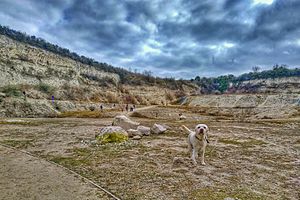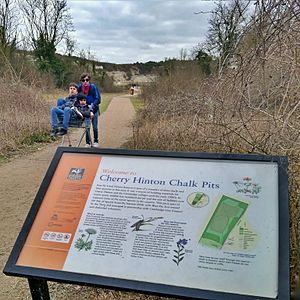Cherry Hinton Pit facts for kids
| Site of Special Scientific Interest | |
 |
|
| Area of Search | Cambridgeshire |
|---|---|
| Interest | Biological |
| Area | 12.8 hectares |
| Notification | 1986 |
| Location map | Magic Map |
Cherry Hinton Pit is a special natural area near Cambridge, England. It covers about 12.8 hectares, which is like 30 football fields! This site is known as a Site of Special Scientific Interest (SSSI) because it has unique plants and wildlife.
The area is made up of two main parts: East Pit and most of West Pit. East Pit is part of a larger area called Limekiln Close and East Pit Local Nature Reserve. This reserve is looked after by the Wildlife Trust for Bedfordshire, Cambridgeshire and Northamptonshire. West Pit is also a separate Local Nature Reserve (LNR).
Contents
Why is Cherry Hinton Pit Special?
Cherry Hinton Pit used to be a place where people dug for chalk. Now, these old quarries have become home to many different plants and animals. You can find grassy areas and woodlands with trees like ash, field maple, and cherry trees.
Rare Plants
This site is very important because it has four rare plant species. Three of these plants are listed on the British Red List of Threatened Species. This list helps us know which plants are in danger of disappearing. The rare plants found here are:
- Great pignut
- Moon carrot
- Grape hyacinth
These plants make Cherry Hinton Pit a very special place for nature lovers and scientists.
A Glimpse into the Past
Cherry Hinton Pit is not just important for nature; it also holds secrets from the past! Archaeologists, who study ancient times, have found some amazing things here.
They discovered human bones, pieces of pottery from the Roman times, and even older pottery from the Iron Age. The Iron Age was a time when people started using iron tools.
One of the most interesting finds is an old ditch from the Iron Age. People often call this ditch the 'War Ditches'. It is believed that this ditch was once part of a large hill fort. A hill fort was a type of fortified settlement built on a hill, used for protection long ago.
Visiting Cherry Hinton Pit
You can visit Cherry Hinton Pit from Limekiln Road. This road runs right between the East Pit and West Pit areas. It's a great place to explore nature and imagine what life was like thousands of years ago!



